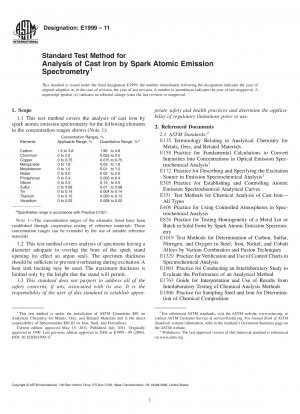ASTM E1999-11
Standard Test Method for Analysis of Cast Iron by Spark Atomic Emission Spectrometry
- Standard No.
- ASTM E1999-11
- Release Date
- 2011
- Published By
- American Society for Testing and Materials (ASTM)
- Status
- Replace By
- ASTM E1999-18
- Latest
- ASTM E1999-23
- Scope
The chemical composition of cast iron alloys shall be determined accurately in order to insure the desired metallurgical properties. This procedure is suitable for manufacturing control and inspection testing.
1.1 This test method covers the optical emission spectrometric analysis of cast iron by use of the point-to-plane technique for the following elements in the concentration ranges shown (Note 1):
Concentration Ranges, % Elements Applicable Range, % Quantitative Range, %A Carbon 1.9 to 3.8 1.90 to 3.8 Chromium 0 to 2.0 0.025 to 2.0 Copper 0 to 0.75 0.015 to 0.75 Manganese 0 to 1.8 0.03 to 1.8 Molybdenum 0 to 1.2 0.01 to 1.2 Nickel 0 to 2.0 0.02 to 2.0 Phosphorus 0 to 0.4 0.005 to 0.4 Silicon 0 to 2.5 0.15 to 2.5 Sulfur 0 to 0.08 0.01 to 0.08 Tin 0 to 0.14 0.004 to 0.14 Titanium 0 to 0.12 0.003 to 0.12 Vanadium 0 to 0.22 0.008 to 0.22 AQuantitative range in accordance with Practice E1601.
Note 1--The concentration ranges of the elements listed have been established through cooperative testing of reference materials. These concentration ranges can be extended by the use of suitable reference materials.
1.2 This test method covers analysis of specimens having a diameter adequate to overlap the bore of the spark stand opening (to effect an argon seal). The specimen thickness should be sufficient to prevent overheating during excitation. A heat sink backing may be used. The maximum thickness is limited only by the height that the stand will permit.
1.3This standard does not purport to address all of the safety concerns, if any, associated with its use. It is the responsibility of the user of this standard to establish appropriate safety and health practices and determine the applicability of regulatory limitations prior to use.
ASTM E1999-11 Referenced Document
- ASTM E1019 Standard Test Methods for Determination of Carbon, Sulfur, Nitrogen, and Oxygen in Steel and in Iron, Nickel, and Cobalt Alloys*, 2024-04-19 Update
- ASTM E1329 Standard Practice for Verification and Use of Control Charts in Spectrochemical Analysis
- ASTM E135 Standard Terminology Relating to Analytical Chemistry for Metals, Ores, and Related Materials
- ASTM E158 Standard Practice for Fundamental Calculations to Convert Intensities into Concentrations in Optical Emission Spectrochemical Analysis (Withdrawn 2004)
- ASTM E1601 Standard Practice for Conducting an Interlaboratory Study to Evaluate the Performance of an Analytical Method
- ASTM E172 Practice for Describing and Specifying the Excitation Source in Emission Spectrochemical Analysis (Withdrawn 2001)
- ASTM E1763 Standard Guide for Interpretation and Use of Results from Interlaboratory Testing of Chemical Analysis Methods
- ASTM E1806 Standard Practice for Sampling Steel and Iron for Determination of Chemical Composition
- ASTM E305 Standard Practice for Establishing and Controlling Spectrochemical Analytical Curves
- ASTM E351 Standard Test Methods for Chemical Analysis of Cast Iron-All Types
- ASTM E406 Standard Practice for Using Controlled Atmospheres in Spectrochemical Analysis
- ASTM E826 Standard Practice for Testing Homogeneity of Materials for Development of Reference Materials
ASTM E1999-11 history
- 2023 ASTM E1999-23 Standard Test Method for Analysis of Cast Iron by Spark Atomic Emission Spectrometry
- 2018 ASTM E1999-18 Standard Test Method for Analysis of Cast Iron by Spark Atomic Emission Spectrometry
- 2011 ASTM E1999-11 Standard Test Method for Analysis of Cast Iron by Spark Atomic Emission Spectrometry
- 1999 ASTM E1999-99(2004) Standard Test Method for Analysis of Cast Iron Using Optical Emission Spectrometry
- 1999 ASTM E1999-99e1 Standard Test Method for Analysis of Cast Iron Using Optical Emission Spectrometry
